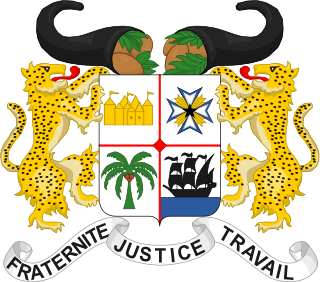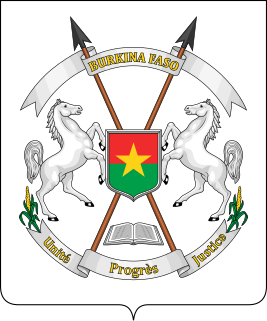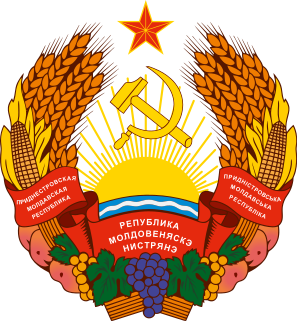 W
WThe coat of arms of the Republic of Adygea, a federal subject of Russia, was adopted on May 24, 1994. It is registered as №163 in the Heraldic Register of the Russian Federation.
 W
WThe coat of arms of Algiers, made by Algeria–Turkey relations, was created after the country's independence, it shows a fortress, which symbolizes the Casbah, and a boat which symbolize the Algerian fleet, vital to the country's economy in older times, as well as two lions, which can be seen in Bab Azzoun, one of the gates of the city. The crescent symbolizes Islam, the state religion, the feather to symbolize scientific and cultural development. The sheaf of corn symbolizes agriculture, while the wheel symbolizes industry.
 W
WThe coat of arms or national seal of Benin, originally introduced in 1964, was readopted in 1990 after being replaced in 1975.
 W
WThe coat of arms of Burkina Faso contains a shield based on the national flag. Above the shield the name of the country is shown, while below it is the national motto, Unité, Progrès, Justice. The supporters are two white stallions. The two plants emerging from the lower banner appear to represent pearl millet, an important cereal grain cultivated in this country where agriculture represents 32% of the gross domestic product. This coat of arms is similar to the old Upper Volta coat of arms, with the Burkina Faso flag replacing the Upper Volta flag in the middle. The coat of arms and its meaning is mandated by Law No 020/97/II/AN.
 W
WThe great seal of the state of Delaware was first adopted on January 17, 1777, with the current version being adopted April 29, 2004. It contains the state coat of arms surrounded by an inscription.
 W
WThe national emblem of East Timor is one of the national symbols of East Timor.
 W
WThe official coat of arms of Grenada is a shield divided into four parts by a golden cross. In the centre of this cross is the Santa Maria, Columbus' flagship. A British lion on a red field is shown in the upper left and lower right sections of the shield, with a golden crescent moon out of which a lily grows in the upper right and lower left sections. Above the shield there is a golden helmet, topped with a garland of bougainvillea branches. Within the garland are seven red roses, which stand for the seven communities of Grenada. Holding the shield on the dexter side is an armadillo which stands before a corn stalk; on the sinister side is a Grenada dove, which stands before a banana plant. The base represents Mount St. Catherine with the Grand Etang Lake at the centre. A ribbon displays the national motto: "Ever conscious of God we aspire, build and advance as one people."
 W
WThe coat of arms of Kenya features two lions, a symbol of protection, holding spears and a traditional East African shield. The shield and spears symbolize unity and defence of freedom. The shield contains the national colours, representing:Black for the people of Kenya. Red for the blood shed during the struggle for freedom. Green for the agriculture and natural resources. White for unity and peace.
 W
WThe coat of arms of the Moldavian Soviet Socialist Republic was adopted on February 10, 1941 by the government of the Moldavian Soviet Socialist Republic. The coat of arms is based on the coat of arms of the Soviet Union. It shows symbols of agriculture, an outer rim featuring wheat, corn, grapes and clover. The red banner bears the Soviet Union state motto in both Moldovan and the Russian language. In Moldovan, it was initially "Пролетарь дин тоате цэриле, униць-вэ!", then, from the 1950s "Пролетарь дин тоате цэриле, уници-вэ!", both transliterated as "Proletari din toate țările, uniți-vă!". The acronym "MSSR" is shown only in Moldovan ("РССМ").
 W
WThe national emblem of Mozambique was adopted in 1990 in the Constitution of Mozambique article 194. The article clearly states the design and meaning of the device. It shows a gear wheel, bordered by corn stalks and sugarcane. In the middle there is a red sun over a map of Mozambique in green, and blue waves, an AK-47 crossed with a hoe, and a book. The wreath is tied with a ribbon bearing the name of the country. The emblem is "socialist heraldry" style similar to those of the Soviet republics.
 W
WThe coat of arms of Pennsylvania is an official emblem of the Commonwealth of Pennsylvania, alongside the seal and state flag, and was adopted in 1778. The flag of Pennsylvania consists of a blue field on which the state coat of arms is displayed.
 W
WThe Emblem of the Transcaucasian SFSR was adopted by the government of the Transcaucasian SFSR. The final version was adopted in 1930.
 W
WThe coat of arms of Transnistria constitutes a remodeled version of the former Moldavian Soviet Socialist Republic emblem, as substituted by the internationally recognized Moldovan government after the dissolution of the Soviet Union in 1991. The only major pictorial change made in the Transnistrian version involves the addition of waves, representing the River Dniester. However, the inscriptions on the banner were changed: unlike the Moldavian SSR emblem, which bore the acronym РССМ and the USSR state slogan "Workers of the world, unite!" in the Russian and Moldavian languages, the Transnistrian emblem bears the name Pridnestrovian Moldavian Republic in the Moldovan, Russian and Ukrainian languages. In the Moldovan Cyrillic version of Romanian, it reads "Република Молдовеняскэ Нистрянэ" ; in Russian, it reads "Приднестровская Молдавская Республика" ; and, in Ukrainian, it reads "Придністровська Молдавська Республіка". Despite the emblem's depiction of the hammer and sickle, Transnistria is not a socialist state.
 W
WThe Great Seal of the State of West Virginia was adopted in September 1863. The obverse center of the seal contains a boulder that has been inscribed June 20, 1863, the date West Virginia became a state. In front of the boulder lie two crossed rifles and a liberty cap as a symbol of the state's fight for liberty. The two men on either side of the boulder represent agriculture and industry. On the left stands a farmer with an ax and plow before a cornstalk. On the other side stands a miner with a pickax, and behind him an anvil and sledge hammer. The outer ring contains the text "State of West Virginia" and the state's motto "Montani Semper Liberi",. The reverse of the seal, also called the lesser seal, is the official seal of the Governor. Its motto reads "Libertas E Fidelitate".
 W
WThe coat of arms of Zambia was adopted on 24 October 1964 when the Republic of Zambia reached its independence. This coat of arms is adapted from the arms of the Colony of Northern Rhodesia which dated to 1927, with the wavy black and white vertical lines as the field and the eagle in the chief.
 W
WThe current coat of arms of Zimbabwe was adopted on 21 September 1981, one year and five months after the national flag was adopted. Previously the coat of arms of Zimbabwe was identical to the former coat of arms of Rhodesia.